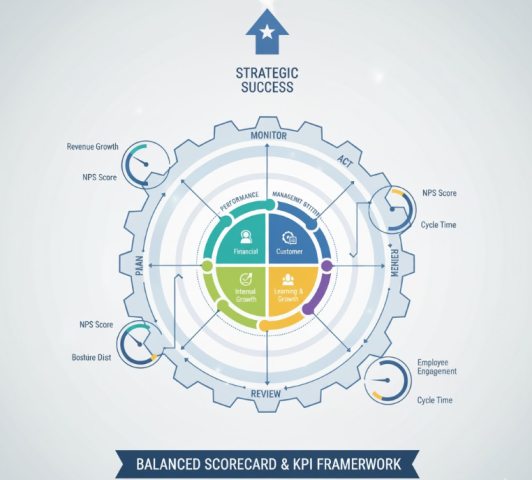Drive Strategic Success: The Essential Role of BSC and KPI in Performance Management

Ứng dụng KPI quản lý hiệu suất trong doanh nghiệp
13 October, 2025Last updated on 13 October, 2025
In today’s fast-paced business world, simply tracking financial results isn’t enough. Organizations need a holistic system to measure progress, align activities, and execute strategy effectively. This is where the Balanced Scorecard (BSC) framework, powered by focused Key Performance Indicators (KPIs), becomes indispensable for modern performance management.
This powerful combination transforms abstract visions into a concrete, measurable roadmap for long-term success.
What is the Balanced Scorecard (BSC)?
Developed by Drs. Robert Kaplan and David Norton, the Balanced Scorecard is a strategic management tool that goes beyond traditional financial metrics to provide a “balanced” view of organizational performance. It ensures that businesses focus on the key drivers of future success, not just short-term gains.
The traditional BSC structures an organization’s objectives and performance measures around four core perspectives:
- Financial: How do we look to shareholders? (e.g., Revenue Growth, Return on Investment (ROI), Profit Margin)
- Customer: How do our customers see us? (e.g., Customer Satisfaction Score (CSAT), Net Promoter Score (NPS), Market Share)
- Internal Processes: What must we excel at? (e.g., Cycle Time, Quality Defect Rate, On-Time Delivery)
- Learning and Growth: Can we continue to improve and create value? (e.g., Employee Engagement Score, Staff Training Hours, Employee Retention Rate)By linking objectives across these four perspectives, the BSC helps create a Strategy Map that illustrates the cause-and-effect relationships driving strategic execution.
The Power of Key Performance Indicators (KPIs)
While the BSC provides the framework for strategy, Key Performance Indicators (KPIs) are the quantifiable metrics that measure the progress toward achieving the objectives defined in the scorecard. A KPI is a critical measure that reflects how effectively a company is achieving key business objectives.
KPIs are the vital signs of a business. They turn abstract goals (like “Improve Customer Satisfaction”) into clear, actionable, and measurable targets (like “Achieve a Net Promoter Score of +50 by Q4”).Characteristics of Effective KPIs:
- Measurable: They are quantifiable and can be tracked consistently.
- Aligned: They directly link to strategic objectives defined in the BSC.
- Actionable: They provide information that can be acted upon to improve performance.
- Timely: They can be tracked and reported with enough frequency to allow for course correction.
A good KPI must be relevant to the strategic goal it is measuring. For example, tracking the “Number of Social Media Likes” might be a useful metric, but it’s unlikely to be a Key Performance Indicator unless social media engagement is a direct, critical driver of a high-level strategic goal (e.g., brand awareness leading to sales).
Application in Performance Management
The integrated application of the BSC and KPIs forms the backbone of a robust, modern performance management system.
Strategy Alignment and Communication
The BSC is a powerful tool for cascading strategy throughout the organization. By developing strategic objectives and associated KPIs at the corporate level and then translating those into relevant scorecards and KPIs for departments, teams, and even individuals, you achieve a clear “line of sight.”
Benefit: Every employee understands how their daily tasks (measured by their individual KPIs) contribute directly to the organizational strategy (defined by the BSC). This improves focus and motivation.Balanced Decision-Making
Relying solely on financial performance can lead to short-sighted decisions (e.g., cutting training budgets to boost short-term profits). The BSC forces leaders to consider all four perspectives simultaneously.
Example: If the Financial objective is “Increase Profitability,” the BSC balances this by requiring attention to the Learning and Growth objective, like “Improve Employee Capabilities,” measured by a KPI like Average Training Hours Per Employee. This ensures long-term capability is not sacrificed for short-term gain.Monitoring and Accountability
KPIs provide the data needed to monitor performance against targets. This data drives performance reviews, budget allocations, and strategic adjustments.
- Leading vs. Lagging Indicators: A key application is pairing these two types of KPIs.
- Lagging Indicators (Outcome Measures): Tell you what already happened (e.g., Quarterly Revenue, Employee Turnover Rate).
- Leading Indicators (Performance Drivers): Predict future results and are actionable in the present (e.g., Sales Pipeline Value, Employee Satisfaction Score).
- The BSC encourages the use of leading indicators (often found in the Internal Processes and Learning & Growth perspectives) to drive the lagging indicators (often found in the Financial and Customer perspectives).Continuous Improvement
Performance management is an ongoing cycle, not a one-time event. The BSC and KPIs facilitate this cycle:
- Plan: Define strategy and objectives (BSC), set measurable targets (KPIs).
- Monitor: Collect and analyze KPI data.
- Review: Use the BSC dashboard to identify performance gaps across all four perspectives.
- Act: Adjust strategic initiatives, resource allocation, and daily operations to close the gaps, leading to a refined plan.
Key Takeaway
For organizations aiming for sustainable growth and effective strategy execution, integrating the Balanced Scorecard framework with robust, strategically aligned Key Performance Indicators is not optional—it’s essential. This system ensures performance management is comprehensive, forward-looking, and fully aligned with the organization’s overarching mission and vision.
Further Readings
Benefits of Using KPI Software in Performance Management
7 Best Project Management Tools in 2025
Why Business Chat Apps Are Essential for Companies
How Project Management Software Help Improve Productivity in Businesses
7 Best KPI Software for Managing Business Performance in 2025




